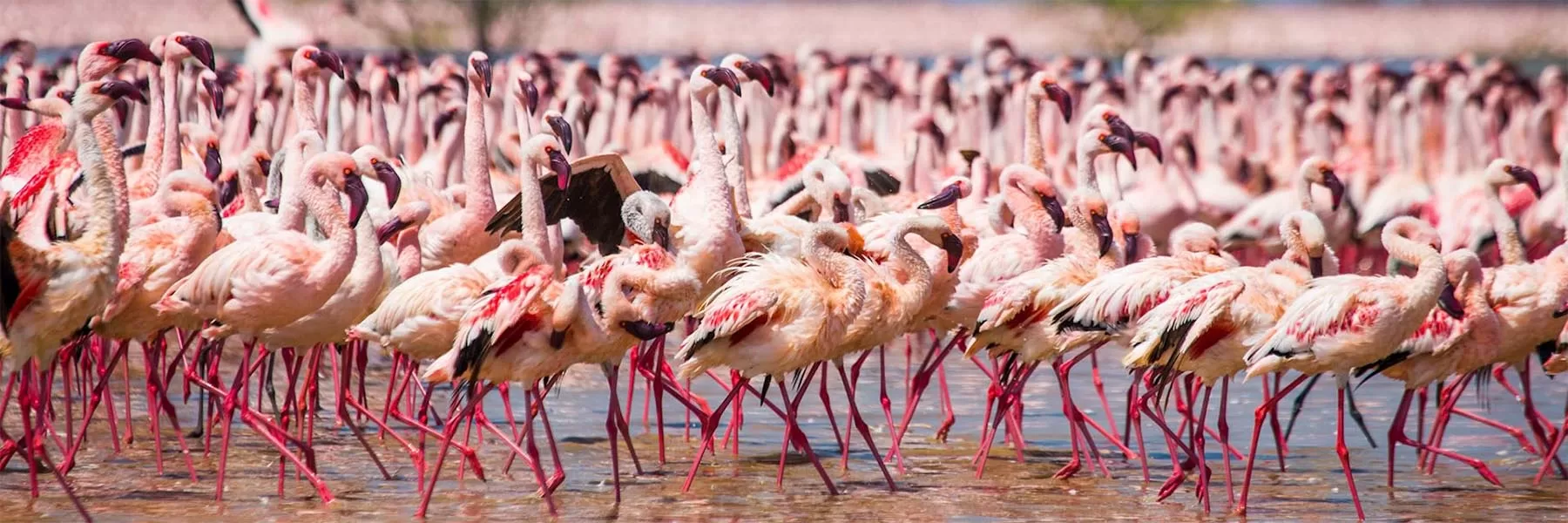Where to see flamingos in Kenya
Flamingos are spectacular birds, dressed in pink feathery coats. Although, there are only six species of flamingos remaining in the world. Yet, they can still be spotted easily by birders. These birds are usually found near wet habitats as they are quite adaptable.
Flamingos are seen in the Caribbean, South America, the Middle East, and near the Mediterranean. However, one of the best spots to see the breathtaking sight of millions of flamingos is in Africa.
 A flock of flamingoes near a river
A flock of flamingoes near a river
With their pretty pink plumage and long legs, flamingos thrive in Africa. They flock in great numbers in various parts of the continent.
Since their movement is based upon different factors, one can’t expect to see flamingos at every corner of the lake or wetland. Nevertheless, you can still stumble upon flamingos considering the right place and the right time.
Before we move on, it is important to know the species of flamingos found in Africa. There are two types of species in Africa:
1. Lesser flamingo
Lesser flamingos are the shortest out of the five species of flamingos. These birds have pink plumage, bills, and legs. In comparison to other species, Lesser flamingos appear to be brighter in color.
They have small heads, and long necks, and stand less than a meter tall. The female flamingos are shorter than the males. Lesser Flamingo can live up to 40 to 50 years in the wild.
 Lesser Flamingo
Lesser Flamingo
Their diet consists of a highly specialized menu entirely of benthic diatoms and microscopic blue-green algae. This is only found in alkaline lakes, saline lagoons, salt pans, and estuaries. To some extent, they may also feed on small aquatic invertebrates such as rotifers.
Lesser flamingos are primarily found in Eastern and Southern Africa. The best spots to observe these birds are near the Rift Valley Lakes, Southern Namibia, and Botswana. They can also be seen in parts of Sudan and Ethiopia.
2. Greater flamingo
The Greater flamingo is the largest out of all the species found. They appear to be pale pink, have a long, lean neck, and have pink bills with a black tip that has a downward curve. Greater flamingos have a majestic wingspan between 1.4 to 1.7 meters.
In the wild, Greater flamingos can live up to 30 to 40 years old. These birds favor warmer and watery regions. They reside near saline or alkaline lakes, and estuaries.
 Greater Flamingo
Greater Flamingo
Their diet consists of crustaceans, mollusks, crabs, insects, worms, and occasionally small fishes. They also feed on shoots, grass seeds, decaying leaves, and algae, and even ingest mud to remove any organic matter it may contain.
Greater flamingos are found in the continents of Africa Asia, Europe, and Oceania.
One way to differentiate between Lesser and Greater flamingos is through their bills. While Lesser flamingos have a darker bill, greater has that of a pink bill.
The strikingly pretty plumage of the flamingoes is not hereditary or even in their DNA. They are initially born with a dull gray color. As they feed on algae and invertebrates, they slowly develop a reddish-pink shade.
 Baby Flamingo or Chick
Baby Flamingo or Chick
This is because algae and invertebrates have special coloring chemicals known as pigments. Thus, one can conclude that flamingos are precisely the expression,’ you are what you eat!
The Great Rift Valley
The Great Rift Valley is one of the most famous highlights in Africa. It is part of the intra- continental ridge system that runs from north to south through Kenya. As Kenya is home to 64 lakes within the African continent, 8 of them are found in the Kenyan Rift Valley.
 An aerial view of the Rift Valley
An aerial view of the Rift Valley
The Rift Valley is covered with exceptional lakes, scenic roads, and exotic wildlife. The picturesque freshwater lakes are some of the best places to find flamingos.
These are some of the famous spots to witness flamingos in Kenya:
1. Lake Bogoria
Lake Bogoria is situated across the border of Kenya. It is famous for its steaming geysers and bubbling thermal springs. This is one of the best places to see millions of flamingos near the water.
 Flamingoes in Lake Bogoria near a steaming geyser
Flamingoes in Lake Bogoria near a steaming geyser
Lake Bogoria is home to the largest population of Lesser flamingos. Many of these birds have migrated from lake Nakuru to Bogoria. You can spot them year-round due to their massive numbers.
However, the best time to witness the alkaline lake turn pink due to flamingos is from August to October.
- How to get to Lake Bogoria
You can either choose to join a safari from Nairobi or rent a car to visit Lake Bogoria independently.
2. Lake Nakuru
Lake Nakuru is one of the Rift Valley’s popular soda lakes. The alkalinity of the lake brings massive flocks of flamingos from all around the world.
The Flamingo birds actually eat blue algae found in Lake Nakuru, so Flamingos are found along the Lake Nakuru coast, making Lake Nakuru appear pink. The flamingos feed mostly on the blue-green algae, the prawns, and some aquatic insects; Lake Nakuru, which is a park, is abundant with the blue-green algae, making it the ideal location for a flamingo. Heavy rainfalls have flooded these lakes as well over recent years, forcing flamingos back into the Lake Nakuru of Kenya’s Nakuru National Park.
 Flamingoes thriving at Lake Nakuru
Flamingoes thriving at Lake Nakuru
Eight years ago, flamingos left Nakuru, never to return due to the lake’s rising water levels. This reduced their feeding and breeding grounds. In the year 2020, the pink birds finally came back to the lake and are presently thriving.
These birds are present at Lake Nakuru park throughout the day, months, and years; therefore, whenever you visit the Nakuru National Park; you are sure to spot some stunningly beautiful pink flamingos enjoying their shores at Lake Nakuru.
We have just missed out on a season when millions of birds blanket Lake Nakuru, Kenya with a pink blanket, but we were fortunate enough to still see a fair number of flamingos feeding on the algae right by the drive-through.
The very salty nature of Lake Nakuru supports an abundance of algae, which is a primary food source for the flamingos, so it draws out the huge flocks, along with pelicans, who are known to nest near the banks.
This has also increased the number of visitors who had diminished as the sightings of flamingos almost vanished. Now, the flocks of lesser flamingos feed on algae and diatoms found in Lake Nakuru. You can also spot more than 400 species of different birds along with flamingos here.
The larger flamingos feed on the creatures found in the mud, including crustaceans, whereas smaller flamingos prosper from floating algae in the lake’s alkaline waters. The flamingo birds’ numbers are further affected by Lake Nakuruas alkalinity, as when alkaline levels are high, blue algae on the lake are also higher, and flamingos in the Lake stay on the Lake.
However, when alkaline levels are lower, algae that flamingos rely on are lower as well, and this causes the flamingos to move towards other soda lakes, like the Borongori flamingo Lake, for food.
The number of flamingo birds is further affected by the alkalinity of Lake Nakuru, in that when the alkaline levels are high the blue algae on the Lake also become high and the flamingos on the Lake remain on the Lake, however, when the alkaline levels drop, the algae where the flamingos depend on also drop and this caused the flamingos to shift to other soda lakes like flamingos Lake Borongori lake to such for food.
There is, however, no guarantee of seeing an overwhelming number of flamingos, since most birds feed on the Lake and they breed, depending on the variation in the rainfall throughout the year, which provides a higher abundance
- How to reach Lake Nakuru
You can easily reach Lake Nakuru by car via a tar road from Nairobi. The lake is also accessible from several other parks such as the Maasai Mara which is a six-hour drive.
Your best bet is to plan your flamingo-watching tour of Lake Nakuru during the dry-hot season in January and February.
There is, though, no warranty that you will see an enormous number of flamingos, as the majority of the birds feed and nest at Lake Nakuru which offers the highest quantity of algae based on seasonal rain variations.
During the prolonged dry season, freshwater sources are limited, around which animals gather. In the dry months, particularly in times of drought, the rosy-throated flocks migrate north from Lake Nakuru to another well-known feeding site for flamingos in Kenya, Lake Bogoria, where the birds are in fact observed all year long. Black rhinos eat algae, created by their droppings mixed into warm waters, as well as plankton.
A trip to Kenya is incomplete without photographing millions of flamingos. Hope you have these places on your travel list to spot the pink birds, for your next trip to Kenya.
If you loved reading this story, then subscribe to our blog here (it will ask to verify your email) to get inspiring travel stories and trivia delivered to your email. Stories about wildlife trivia, cultural experiences, curated luxury hotel lists, underrated places to travel, polar journeys, and much more.











